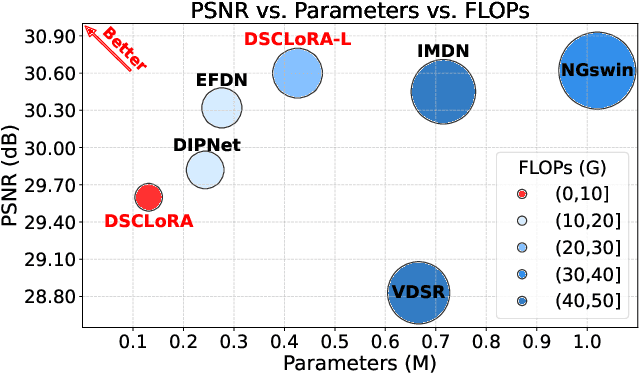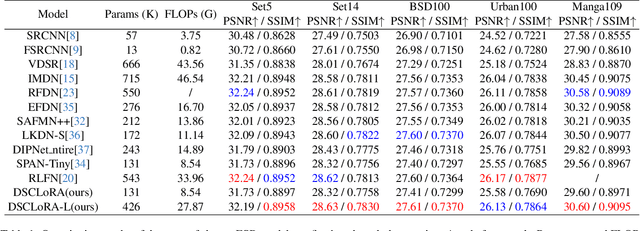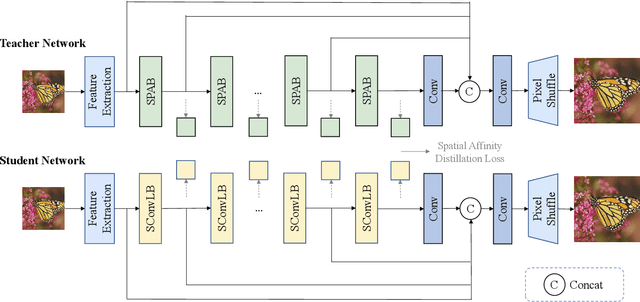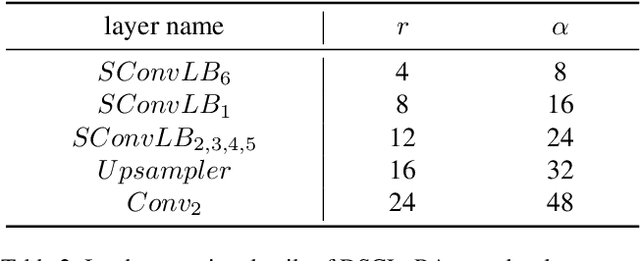Yao Zhang
Shanghai AI Laboratory, China
REFINE-CONTROL: A Semi-supervised Distillation Method For Conditional Image Generation
Sep 26, 2025Abstract:Conditional image generation models have achieved remarkable results by leveraging text-based control to generate customized images. However, the high resource demands of these models and the scarcity of well-annotated data have hindered their deployment on edge devices, leading to enormous costs and privacy concerns, especially when user data is sent to a third party. To overcome these challenges, we propose Refine-Control, a semi-supervised distillation framework. Specifically, we improve the performance of the student model by introducing a tri-level knowledge fusion loss to transfer different levels of knowledge. To enhance generalization and alleviate dataset scarcity, we introduce a semi-supervised distillation method utilizing both labeled and unlabeled data. Our experiments reveal that Refine-Control achieves significant reductions in computational cost and latency, while maintaining high-fidelity generation capabilities and controllability, as quantified by comparative metrics.
SwarmAgentic: Towards Fully Automated Agentic System Generation via Swarm Intelligence
Jun 18, 2025Abstract:The rapid progress of Large Language Models has advanced agentic systems in decision-making, coordination, and task execution. Yet, existing agentic system generation frameworks lack full autonomy, missing from-scratch agent generation, self-optimizing agent functionality, and collaboration, limiting adaptability and scalability. We propose SwarmAgentic, a framework for fully automated agentic system generation that constructs agentic systems from scratch and jointly optimizes agent functionality and collaboration as interdependent components through language-driven exploration. To enable efficient search over system-level structures, SwarmAgentic maintains a population of candidate systems and evolves them via feedback-guided updates, drawing inspiration from Particle Swarm Optimization (PSO). We evaluate our method on six real-world, open-ended, and exploratory tasks involving high-level planning, system-level coordination, and creative reasoning. Given only a task description and an objective function, SwarmAgentic outperforms all baselines, achieving a +261.8% relative improvement over ADAS on the TravelPlanner benchmark, highlighting the effectiveness of full automation in structurally unconstrained tasks. This framework marks a significant step toward scalable and autonomous agentic system design, bridging swarm intelligence with fully automated system multi-agent generation. Our code is publicly released at https://yaoz720.github.io/SwarmAgentic/.
Agentic Neural Networks: Self-Evolving Multi-Agent Systems via Textual Backpropagation
Jun 10, 2025Abstract:Leveraging multiple Large Language Models(LLMs) has proven effective for addressing complex, high-dimensional tasks, but current approaches often rely on static, manually engineered multi-agent configurations. To overcome these constraints, we present the Agentic Neural Network(ANN), a framework that conceptualizes multi-agent collaboration as a layered neural network architecture. In this design, each agent operates as a node, and each layer forms a cooperative "team" focused on a specific subtask. Agentic Neural Network follows a two-phase optimization strategy: (1) Forward Phase-Drawing inspiration from neural network forward passes, tasks are dynamically decomposed into subtasks, and cooperative agent teams with suitable aggregation methods are constructed layer by layer. (2) Backward Phase-Mirroring backpropagation, we refine both global and local collaboration through iterative feedback, allowing agents to self-evolve their roles, prompts, and coordination. This neuro-symbolic approach enables ANN to create new or specialized agent teams post-training, delivering notable gains in accuracy and adaptability. Across four benchmark datasets, ANN surpasses leading multi-agent baselines under the same configurations, showing consistent performance improvements. Our findings indicate that ANN provides a scalable, data-driven framework for multi-agent systems, combining the collaborative capabilities of LLMs with the efficiency and flexibility of neural network principles. We plan to open-source the entire framework.
SCOP: Evaluating the Comprehension Process of Large Language Models from a Cognitive View
Jun 05, 2025



Abstract:Despite the great potential of large language models(LLMs) in machine comprehension, it is still disturbing to fully count on them in real-world scenarios. This is probably because there is no rational explanation for whether the comprehension process of LLMs is aligned with that of experts. In this paper, we propose SCOP to carefully examine how LLMs perform during the comprehension process from a cognitive view. Specifically, it is equipped with a systematical definition of five requisite skills during the comprehension process, a strict framework to construct testing data for these skills, and a detailed analysis of advanced open-sourced and closed-sourced LLMs using the testing data. With SCOP, we find that it is still challenging for LLMs to perform an expert-level comprehension process. Even so, we notice that LLMs share some similarities with experts, e.g., performing better at comprehending local information than global information. Further analysis reveals that LLMs can be somewhat unreliable -- they might reach correct answers through flawed comprehension processes. Based on SCOP, we suggest that one direction for improving LLMs is to focus more on the comprehension process, ensuring all comprehension skills are thoroughly developed during training.
Does Machine Unlearning Truly Remove Model Knowledge? A Framework for Auditing Unlearning in LLMs
May 29, 2025



Abstract:In recent years, Large Language Models (LLMs) have achieved remarkable advancements, drawing significant attention from the research community. Their capabilities are largely attributed to large-scale architectures, which require extensive training on massive datasets. However, such datasets often contain sensitive or copyrighted content sourced from the public internet, raising concerns about data privacy and ownership. Regulatory frameworks, such as the General Data Protection Regulation (GDPR), grant individuals the right to request the removal of such sensitive information. This has motivated the development of machine unlearning algorithms that aim to remove specific knowledge from models without the need for costly retraining. Despite these advancements, evaluating the efficacy of unlearning algorithms remains a challenge due to the inherent complexity and generative nature of LLMs. In this work, we introduce a comprehensive auditing framework for unlearning evaluation, comprising three benchmark datasets, six unlearning algorithms, and five prompt-based auditing methods. By using various auditing algorithms, we evaluate the effectiveness and robustness of different unlearning strategies. To explore alternatives beyond prompt-based auditing, we propose a novel technique that leverages intermediate activation perturbations, addressing the limitations of auditing methods that rely solely on model inputs and outputs.
Knowledge Guided Encoder-Decoder Framework: Integrating Multiple Physical Models for Agricultural Ecosystem Modeling
May 13, 2025



Abstract:Agricultural monitoring is critical for ensuring food security, maintaining sustainable farming practices, informing policies on mitigating food shortage, and managing greenhouse gas emissions. Traditional process-based physical models are often designed and implemented for specific situations, and their parameters could also be highly uncertain. In contrast, data-driven models often use black-box structures and does not explicitly model the inter-dependence between different ecological variables. As a result, they require extensive training data and lack generalizability to different tasks with data distribution shifts and inconsistent observed variables. To address the need for more universal models, we propose a knowledge-guided encoder-decoder model, which can predict key crop variables by leveraging knowledge of underlying processes from multiple physical models. The proposed method also integrates a language model to process complex and inconsistent inputs and also utilizes it to implement a model selection mechanism for selectively combining the knowledge from different physical models. Our evaluations on predicting carbon and nitrogen fluxes for multiple sites demonstrate the effectiveness and robustness of the proposed model under various scenarios.
Distillation-Supervised Convolutional Low-Rank Adaptation for Efficient Image Super-Resolution
Apr 15, 2025



Abstract:Convolutional neural networks (CNNs) have been widely used in efficient image super-resolution. However, for CNN-based methods, performance gains often require deeper networks and larger feature maps, which increase complexity and inference costs. Inspired by LoRA's success in fine-tuning large language models, we explore its application to lightweight models and propose Distillation-Supervised Convolutional Low-Rank Adaptation (DSCLoRA), which improves model performance without increasing architectural complexity or inference costs. Specifically, we integrate ConvLoRA into the efficient SR network SPAN by replacing the SPAB module with the proposed SConvLB module and incorporating ConvLoRA layers into both the pixel shuffle block and its preceding convolutional layer. DSCLoRA leverages low-rank decomposition for parameter updates and employs a spatial feature affinity-based knowledge distillation strategy to transfer second-order statistical information from teacher models (pre-trained SPAN) to student models (ours). This method preserves the core knowledge of lightweight models and facilitates optimal solution discovery under certain conditions. Experiments on benchmark datasets show that DSCLoRA improves PSNR and SSIM over SPAN while maintaining its efficiency and competitive image quality. Notably, DSCLoRA ranked first in the Overall Performance Track of the NTIRE 2025 Efficient Super-Resolution Challenge. Our code and models are made publicly available at https://github.com/Yaozzz666/DSCF-SR.
The Tenth NTIRE 2025 Efficient Super-Resolution Challenge Report
Apr 14, 2025Abstract:This paper presents a comprehensive review of the NTIRE 2025 Challenge on Single-Image Efficient Super-Resolution (ESR). The challenge aimed to advance the development of deep models that optimize key computational metrics, i.e., runtime, parameters, and FLOPs, while achieving a PSNR of at least 26.90 dB on the $\operatorname{DIV2K\_LSDIR\_valid}$ dataset and 26.99 dB on the $\operatorname{DIV2K\_LSDIR\_test}$ dataset. A robust participation saw \textbf{244} registered entrants, with \textbf{43} teams submitting valid entries. This report meticulously analyzes these methods and results, emphasizing groundbreaking advancements in state-of-the-art single-image ESR techniques. The analysis highlights innovative approaches and establishes benchmarks for future research in the field.
Orchestrating Joint Offloading and Scheduling for Low-Latency Edge SLAM
Feb 23, 2025Abstract:Visual Simultaneous Localization and Mapping (vSLAM) is a prevailing technology for many emerging robotic applications. Achieving real-time SLAM on mobile robotic systems with limited computational resources is challenging because the complexity of SLAM algorithms increases over time. This restriction can be lifted by offloading computations to edge servers, forming the emerging paradigm of edge-assisted SLAM. Nevertheless, the exogenous and stochastic input processes affect the dynamics of the edge-assisted SLAM system. Moreover, the requirements of clients on SLAM metrics change over time, exerting implicit and time-varying effects on the system. In this paper, we aim to push the limit beyond existing edge-assist SLAM by proposing a new architecture that can handle the input-driven processes and also satisfy clients' implicit and time-varying requirements. The key innovations of our work involve a regional feature prediction method for importance-aware local data processing, a configuration adaptation policy that integrates data compression/decompression and task offloading, and an input-dependent learning framework for task scheduling with constraint satisfaction. Extensive experiments prove that our architecture improves pose estimation accuracy and saves up to 47% of communication costs compared with a popular edge-assisted SLAM system, as well as effectively satisfies the clients' requirements.
Memory Helps, but Confabulation Misleads: Understanding Streaming Events in Videos with MLLMs
Feb 21, 2025Abstract:Multimodal large language models (MLLMs) have demonstrated strong performance in understanding videos holistically, yet their ability to process streaming videos-videos are treated as a sequence of visual events-remains underexplored. Intuitively, leveraging past events as memory can enrich contextual and temporal understanding of the current event. In this paper, we show that leveraging memories as contexts helps MLLMs better understand video events. However, because such memories rely on predictions of preceding events, they may contain misinformation, leading to confabulation and degraded performance. To address this, we propose a confabulation-aware memory modification method that mitigates confabulated memory for memory-enhanced event understanding.
 Add to Chrome
Add to Chrome Add to Firefox
Add to Firefox Add to Edge
Add to Edge